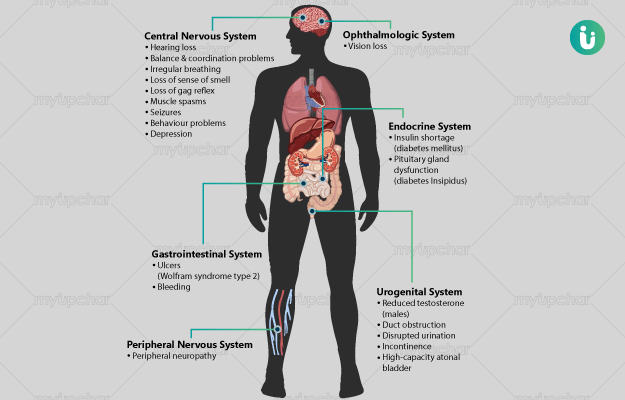What is Wolfram syndrome?
Wolfram syndrome is a rare genetic neurodegenerative disorder. It was first described by Wolfram and Wagener. It manifests as non-inflammatory degenerative changes in the brain and pancreatic islets resulting in diabetes insipidus, diabetes mellitus, damage to the optic nerve, and deafness (DIDMOAD).
What are its main associated signs and symptoms?
The main signs and symptoms of Wolfram syndrome include:
- Primary symptoms of Wolfram syndrome (diabetes mellitus, optic atrophy, diabetes insipidus, and deafness)
- Juvenile insulin dependent diabetes mellitus
- Frequent urination
- Excessive thirst
- Increased appetite
- Weight loss
- Blurred vision
- Urinary tract abnormalities
- Neurological symptoms: Poor balance, an awkward way of walking (ataxia), and sleep apnoea can occur.
- Psychiatric and behavioural problems such as depression and anxiety
- Lowered production of testosterone in males (hypogonadism)
- Gastrointestinal symptoms: Constipation, trouble swallowing, diarrhoea, and choking
- Cataract
- Issues with temperature regulation
What are the main causes?
Wolfram syndrome is caused due to inherited autosomal recessive genetic mutations in the WFS1 gene (most common) or WFS2 gene. Children of consanguineous parents (descended from the same ancestor) have a higher chance of carrying the defective recessive genes, which they can pass on to their children. The dominant genetic disorder can also occur if a single parent has a defective gene, which is inherited by the child.
How is it diagnosed and treated?
In most cases, it is difficult to diagnose Wolfram syndrome. However, diagnosis includes:
- Testing for diabetes mellitus
- Eye examination
- Hearing loss evaluation
- Molecular genetic testing to detect mutations in the WFS1 and WFS2 genes
- Brain MRI
- Anti-glutamic acid decarboxylase and anti-islet cell antibodies testing
- Hypogonadism (males)
- Urological signs
Treatment of Wolfram syndrome is based on symptomatic and supportive management, which includes insulin treatment, oral vasopressin, hearing aids, or cochlear implants. Occupational therapy may be helpful, antibiotics in case of urinary tract infections, lipid-lowering drug therapy in case of dyslipidaemias, and anti-hypertensive drug for hypertension may also be initiated.
















